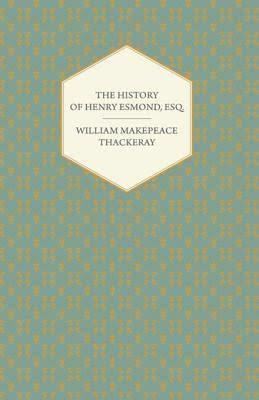7 /10 1 Votes7
Country England Publication date 1852 Pages 464 Genre Historical Fiction | 3.5/5 Goodreads Language English Media type Print Originally published 1852 Page count 464 Publisher Smith, Elder & Co. | |||||||||||||||||||||||||||||||||
 | ||||||||||||||||||||||||||||||||||
Original title The History of Henry Esmond, Esq., A Colonel in the Service of Her Majesty Queen Anne Similar Pendennis, The Virginians, The Newcomes, The Book of Snobs, The Luck of Barry Lyndon | ||||||||||||||||||||||||||||||||||
The history of henry esmond by william makepeace thackeray part 1of3 book reading british english
The History of Henry Esmond is a historical novel by William Makepeace Thackeray, originally published in 1852. The book tells the story of the early life of Henry Esmond, a colonel in the service of Queen Anne of England. A typical example of Victorian historical novels, Thackeray's work of historical fiction tells its tale against the backdrop of late 17th- and early 18th-century England – specifically, major events surrounding the English Restoration — and utilises characters both real (but dramatised) and imagined.
Contents
- The history of henry esmond by william makepeace thackeray part 1of3 book reading british english
- The history of henry esmond by william makepeace thackeray part 2of3 book reading british english
- Plot summary
- Reception
- Sequel
- Queen Anne style
- References
The history of henry esmond by william makepeace thackeray part 2of3 book reading british english
Plot summary
Using sporadically the first and third persons, Henry Esmond relates his own history in memoir fashion. The novel opens on Henry as a boy – the supposedly illegitimate (and eventually orphaned) son of Thomas, the third Viscount Castlewood, and cousin of the Jacobite fourth viscount, Francis, and his wife, the Lady Castlewood. These successors to the Castlewood estate and peerage, following the death of Henry's father, foster the boy, and he remains with them throughout his youth and early adulthood.
A quiet, sober, hard-working youth, Henry is devoted to his foster family. Gentle, sensitive Lady Castlewood is his adored mother figure. Her husband is also kind to Esmond, but the hard-drinking viscount is clearly a man of limited intellect whose crude manners and thoughtless ways cause his wife a great deal of embarrassment and pain.
Henry Esmond knows that his cousins—dull, good-natured Frank and sly, seductive Beatrix—will eventually inherit Castlewood. After the heartless Beatrix rejects his offer of marriage, he journeys to London to make his fortune. Esmond meets many of the celebrated English writers of the day, such as Joseph Addison and Richard Steele. Addison and Steele are both represented as model English gentlemen, who gladly mentor Esmond in his literary career, while the equally noted Jonathan Swift is depicted in most unflattering terms as a hateful misanthrope and bully. Particular venom is directed at Swift for the abundant leisure he had at the vicarage in Trim, County Meath for cultivating his garden, making a canal (after the Dutch fashion of Moor Park), and planting willows.
When his writing career stalls, Esmond joins the British army. Here he is reunited with his cousin Frank, who is now a dashing but foolhardy young officer. The two cousins later join the unsuccessful campaign to restore James Francis Edward Stuart to the English throne. After much intrigue, Esmond grows disillusioned with Jacobitism and eventually comes to accept the Protestant future of England. He falls in love with his cousin (daughter of his patron, Castlewood), Beatrix, but eventually marries his foster-mother (also his cousin, and Beatrix's mother), Rachel, Lady Castlewood. The novel closes on the couple's emigration to Virginia in 1718.
Reception
In a private critique of the work, written in a letter to a friend, novelist George Eliot labelled it "the most uncomfortable book you can imagine...the hero is in love with the daughter all through the book, and marries the mother at the end." However, American publisher and novelist James Thomas Fields, in his autobiographical Yesterdays with Authors, said of the book, and of his friend Thackeray:
To my thinking, it is a marvel in literature, and I have read it oftener than any of the other works. Perhaps the reason of my partiality lies somewhat in this little incident. One day, in the snowy winter of 1852, I met Thackeray sturdily ploughing his way down Beacon Street with a copy of Henry Esmond (the English edition, then just issued) under his arm. Seeing me some way off, he held aloft the volumes and began to shout in great glee. When I came up to him he cried out, "Here is the very best I can do, and I am carrying it to Prescott as a reward of merit for having given me my first dinner in America. I stand by this book, and am willing to leave it, when I go, as my card."
Anthony Trollope thought Thackeray the greatest novelist of his time and Esmond his masterpiece.
Ippolito Nievo's novel "Confessions of an Italian" shows analogies with "The History of Henry Esmond", both in the fundamental structure of the plot, in the psychological outlines of the main characters, in frequent episodes and in the use of metaphors.
Sequel
The sequel to this novel was The Virginians, written in 1857–59. It takes place in both England and America, and details the lives of Esmond's grandsons, brothers George and Henry Warrington.
"Queen Anne style"
Although popularised by British architects George Devey and Richard Norman Shaw, the anachronistic "Queen Anne" design style created in the latter part of the 19th century, for both buildings and furniture, won its Victorian nomenclature via readers' enthusiasm for Thackeray's detailed descriptions of that period in Henry Esmond.
Thackeray visited Clevedon Court in Clevedon, Somerset in 1848 and the house was the inspiration for the setting of Castlewood. His printers added to the period atmosphere of the novel by printing it entirely in Caslon types from the 1730s, using the long s.
